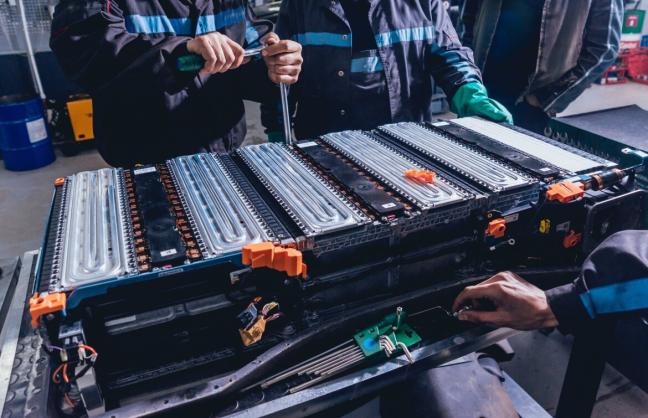Decoding The Economic Viability Of Lithium-Ion Battery Recycling
Nov 6, 2023 | Pratirodh Bureau
Lithium-ion can be repurposed through second-life applications to utilize their capacity (Photo by Shutterstock)
As the number of electric vehicles on Indian roads increase, a surge in discarded lithium-ion batteries (LIBs) is expected, underscoring the urgent need for a robust recycling ecosystem. This blog looks at the economic feasibility of a large-scale recycling unit and makes the case for the development of a circular economy.
Under its G20 Presidency, India has launched the Resource Efficiency and Circular Economy Industry Coalition (RECEIC) for global sustainable environmental impact. To further promote research commercialization and the adoption of a circular economy for battery waste, the Ministry of Electronics and Information Technology recently transferred cost-effective Li-ion battery recycling technology to nine recycling industries and start-ups as part of Mission LiFE’s ‘Promote Circularity Campaign’.
Lithium-ion batteries (LIBs) completing their life in electric vehicle (EV) applications can be repurposed to utilize their remaining capacity in second-life applications, after which they reach their end of life and become a major source of e-waste.
Driven by rising demand for EVs, the LIB global market demand is expected to reach 2.8 TWh by 2030. As a result, the demand for critical materials is expected to increase, with the demand for lithium expected to increase by 5.3 times and cobalt by 5.2 times from the 2020 levels by 2030. This surge could potentially create a supply shortage of 21% for lithium and 18% for cobalt.
Recycling end-of-life LIBs can help address this material scarcity by reducing dependence on lithium mining by 25%, and cobalt by 35%. It would also ensure the local availability of recycled critical materials.
In India, the LIB recycling industry is currently dominated by retired batteries from portable electronic products. But in the future, LIBs from EVs are expected to dominate the recycling market which will require large-scale recycling units. Currently, hydrometallurgy and pyrometallurgy are the most widely used recycling technologies, while direct recycling is an emerging technology. The heterogeneity in battery cathode chemistries such as NMC (Nickel-Manganese-Cobalt), NCA (Nickel-Cobalt-Aluminum), LFP (Lithium-Iron-Phosphate) and LMO (Lithium-Manganese Oxide) complicate the development of feasible recycling business models with any given recycling technology. Understanding the factors that influence the financial feasibility of recycling units can help identify the necessary steps for enabling a sustainable recycling ecosystem in India.
Cost Components of Recycling Plants
The direct cost, which includes infrastructure, equipment, installation, etc., accounts for ~58% of the total capital cost. Indirect cost, which includes engineering, project management, insurance, freight and taxes, account for around 32%, and contingency accounts for around 10% of the total capital cost. The operational expenditures majorly include chemicals and consumables (33%), utilities & services (26%), labor cost (23%), etc.
To develop a robust LIB recycling ecosystem, it is important to identify the possible pathways that ensure business profitability. A recent study has highlighted the role of transport distances, wages, pack designs, battery chemistries and a selection of suitable recycling technologies in determining operating profit/loss, called the Net Recycling Profits (NRP). For example, a comparative analysis of domestic battery recycling in United Kingdom, with batteries sent to China and the United States from UK for recycling, shows that transportation accounts for 2% of the total recycling cost for the UK while it is 7-13% for the other two countries. Further, the disassembly of batteries accounts for 2% of the recycling cost for batteries sent to China, 8–11% for batteries sent to the U.S., and 12–17% for domestic recycling in the UK. For the widely used hydrometallurgy recycling process, the NRP for the different battery chemistries is better in China, as compared to the US and the UK, despite the higher transportation costs, mainly due to lower labor costs in China.
Financial Feasibility: Battery Chemistry and Recycling Technologies
The value of metals recovered from batteries and the cost-effectiveness of the recycling technologies affect the profitability of battery recycling. NMC and NCA batteries generate higher revenue than LFP and LMO batteries due to the presence of high-value critical metals (cobalt). Copper can be a good revenue source beyond cathode material. For batteries with high-valued material, hydrometallurgy technology can be better as compared to pyrometallurgy for profitability, whereas for batteries without high-valued material, only a direct recycling method can ensure profitability.
Furthermore, the economies of scale analysis for recycling profitability suggests that the break-even point for the recycling profitability of NCA batteries can be achieved with an annual recycling capacity of 17,000 tons for pyrometallurgy, 7,000 tons for hydrometallurgy, and 3,000 tons for direct recycling technology. The profitable economies of scale for NCA battery recycling without revenue from cobalt increases to an annual capacity of over 50,000 tons for pyrometallurgy, and ~17,000 tons for hydrometallurgy.
Way Forward
To ensure financial feasibility, it is important to achieve low operational costs with possible automation, domestic recycling with lower transportation costs, and adoption of suitable recycling technology. The following steps can help India achieve the financial feasibility of recycling units:
- Developing decentralized facilities for LIB recycling and meeting the economies of scale will improve financial feasibility and help reduce storage and transportation challenges
- Original equipment manufacturers (OEMs) should introduce reuse and recycling-friendly battery pack designs to reduce the cost and complexity of battery disassembly
- Academia-industry-government collaborations can support the R&D requirement for safe, environment-friendly, and cost-effective reuse and recycling processes
- A capacity building plan can minimize safety risks and improve process efficiencies
(Published under Creative Commons from World Resources Institute. Read the original article here)
